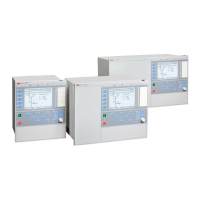important to have the latest recordings in the memory. The saturation mode is
preferred, when the oldest recordings are more important.
New triggerings are blocked in both the saturation and the overwrite mode until the
previous recording is completed. On the other hand, a new triggering can be accepted
before all pre-trigger samples are collected for the new recording. In such a case, the
recording is as much shorter as there were pre-trigger samples lacking.
8.2.2.10 Exclusion mode
Exclusion mode is on, when the value set with the Exclusion time parameter is higher
than zero. During the exclusion mode, new triggerings are ignored if the triggering
reason is the same as in the previous recording. The Exclusion time parameter controls
how long the exclusion of triggerings of same type is active after a triggering. The
exclusion mode only applies to the analog and binary channel triggerings, not to
periodic and manual triggerings.
When the value set with the Exclusion time parameter is zero, the exclusion mode is
disabled and there are no restrictions on the triggering types of the successive
recordings.
The exclusion time setting is global for all inputs, but there is an individual counter for
each analog and binary channel of the disturbance recorder, counting the remaining
exclusion time. The user can monitor the remaining exclusion time with the Exclusion
time rem parameter (only visible via communication, IEC 61850 data ExclTmRmn)
of the corresponding analog or binary channel. The Exclusion time rem parameter
counts downwards.
8.2.3 Configuration
The disturbance recorder can be configured with PCM600 or any tool supporting the
IEC 61850 standard.
The disturbance recorder can be enabled or disabled with the Operation parameter
under the Configuration/Disturbance recorder/General menu.
One analog signal type of the protection relay can be mapped to each of the analog
channels of the disturbance recorder. The mapping is done with the Channel selection
parameter of the corresponding analog channel. The name of the analog channel is
user-configurable. It can be modified by writing the new name to the Channel id text
parameter of the corresponding analog channel.
Any external or internal digital signal of the protection relay which can be
dynamically mapped can be connected to the binary channels of the disturbance
recorder. These signals can be, for example, the start and trip signals from protection
function blocks or the external binary inputs of the protection relay.The connection is
made with dynamic mapping to the binary channel of the disturbance recorder using,
for example, SMT of PCM600. It is also possible to connect several digital signals to
one binary channel of the disturbance recorder. In that case, the signals can be
1MRS758755 A Section 8
Measurement functions
REC615 and RER615 597
Technical Manual

